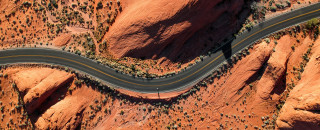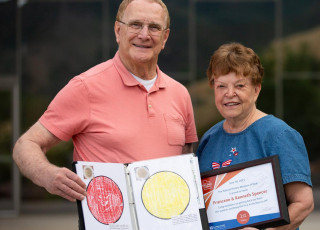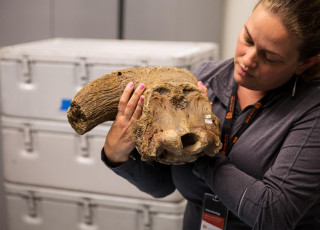Explorer Corps App: A Utah Road-tripper’s Best Friend
By Lisa Potter
Snacks? Check. Playlist? Check. Explorer Corps app? CHECK!
The Natural History Museum of Utah’s free Explorer Corps mobile app is like road-tripping with dozens of experts in the car, pointing out Utah’s wonders. Explorer Corps marks 29 points of geological, historical and cultural interest across the state that users seek, like a scavenger hunt, until they find them all.
Download the free tool before Labor Day, Monday Sept. 2, 2024, to enter a summer sweepstakes to win a prize pack of nearly $1,000 in camping equipment. If you’ve downloaded the app, then you’re already eligible!
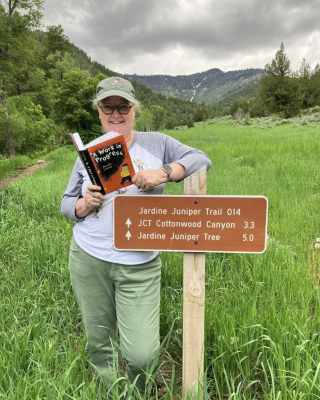
Lisa Morey stands at the trailhead to the Jardine Juniper, a 1,500-year-old, 40-foot-tall and 23.6 feet in diameter tree.
“I’ve lived in Utah my whole life. I felt like I’d been everywhere, but the app directs you to places you don’t know about,” said Lisa Morey, a school librarian and avid Explorer Corps user. “I love it because it takes you where you might not normally go, and it’s an easy way to keep track of these places.”
The museum consulted with experts to mark 29 destinations, one in each of Utah’s counties, from the culturally significant Promontory Caves in Box Elder County to the breathtaking Comb Ridge in San Juan County. The app tracks your location in real time, allowing travelers to make stops along their charted course and check in at different markers. It also suggests road trips that string together selected markers to learn more about topics like Utah’s dinosaurs or first human inhabitants. Click on a location to read fast facts, a science story and suggestions for activities to do in the area.
“We went to the marker in Mt. Timpanogos after reading about it with the grandkids. The kids showed up with questions for the rangers. It made it more fun than just going on a hike,” said Morey.
Carrie Levitt-Bussian holding the musk ox skull that was found in downtown Salt Lake City.
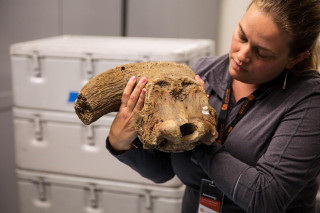
Carrie Levitt-Bussian holding the musk ox skull that was found in downtown Salt Lake City. Photo by Mark Johnston
The app includes marvels such as a 1,500-year-old Jardin Juniper in Cache County, one of the largest Kayenta Anasazi settlements in Garfield County, and the world-famous rock-climbing destination of Maple Canyon in Sanpete County. However, you don’t have to go far—a great place to start is in the U’s backyard.
On May 17, 1871, Salt Lake City’s former mayor Robert N. Baskins was redoing his basement near today’s Temple Square. Workers were shocked to find a “petrified buffalo head” as they dug six feet into Ice Age-aged gravel. The skull was an ancient musk ox that lived tens of thousands of years ago in a much-colder Salt Lake Valley. The Salt Lake Tribune and the Utah Mining Gazette reported on the discovery at the time. The skull now lives in the museum’s collections.
“When people think of Utah, they think of dinosaurs. This is not a dinosaur—this was found downtown,” said Carrie Levitt-Bussian, paleontology collections manager at the museum. “People usually think you have to go to southern Utah to find fossils. But literally, if you excavate right beneath our feet on the University of Utah campus, you’ll probably find these ice age animals.”
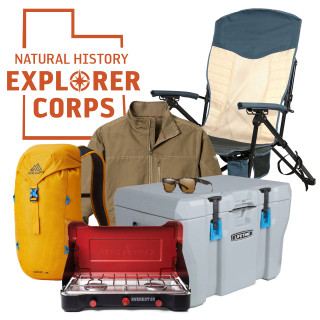
In fact, the Huntsman Cancer Center found a musk ox during the construction of one of their buildings. A taxidermy of a modern musk ox is on display in NHMU’s Past World’s gallery. Load up the app to find the musk ox marker outside the museum, then start your own road trip to check off as many markers as you can. Not only will you learn something new along the way, if you download the app before Labor Day, you may win nearly $1,000 in camping gear to complement your next trip!
